The Epidemiology of Fetal Growth and Ischaemic Heart Disease
VerifiedAdded on 2020/02/18
|5
|1172
|332
Report
AI Summary
This report examines the crucial relationship between fetal growth and the subsequent risk of ischaemic heart disease (IHD), drawing on research by Leon et al. (1998) and others. The study highlights that reduced fetal growth, often associated with low birth weight, significantly elevates the likelihood of developing heart conditions. The report discusses how insufficient nutrients, adverse environmental factors, and placental dysfunction can impair fetal development, leading to potential heart problems later in life. It also covers how advancements in medical technology, like ultrasounds, have improved the ability to monitor fetal health and intervene early. The conclusion underscores the critical link between fetal growth and IHD risk, emphasizing the importance of maternal health and early medical care to mitigate these risks. References to Baschat (2011), Dawber et al. (2015), Finegold et al. (2013), and others support the findings.
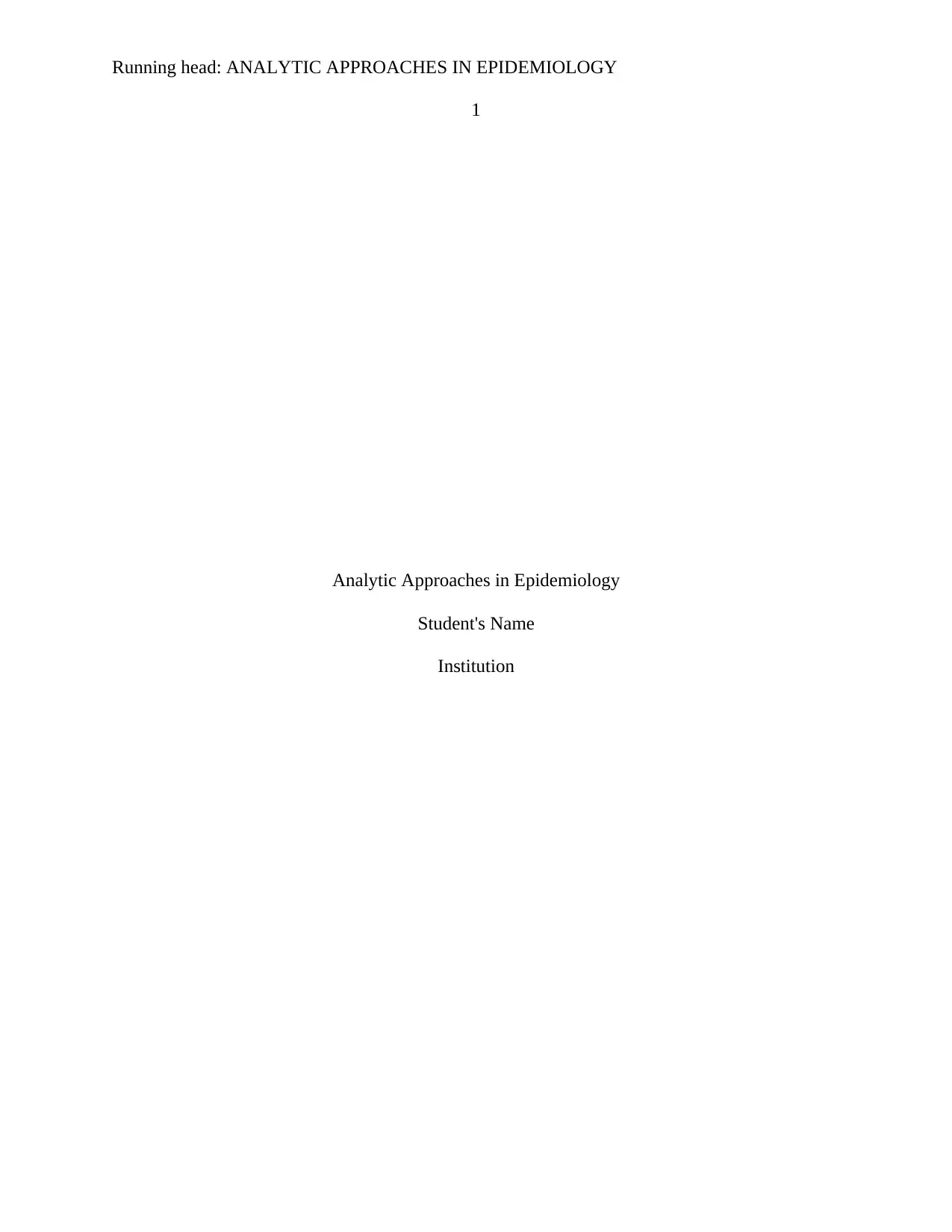
Running head: ANALYTIC APPROACHES IN EPIDEMIOLOGY
1
Analytic Approaches in Epidemiology
Student's Name
Institution
1
Analytic Approaches in Epidemiology
Student's Name
Institution
Paraphrase This Document
Need a fresh take? Get an instant paraphrase of this document with our AI Paraphraser
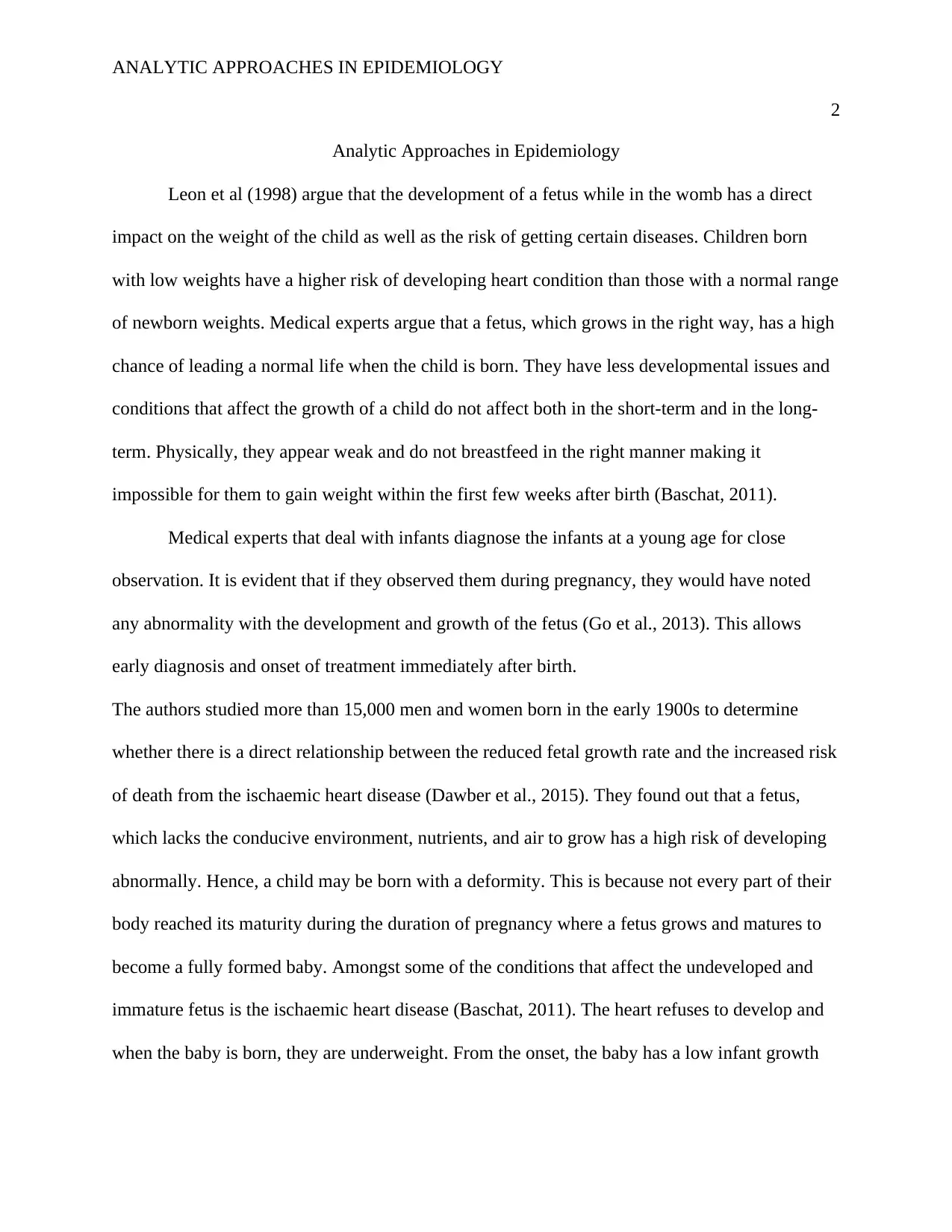
ANALYTIC APPROACHES IN EPIDEMIOLOGY
2
Analytic Approaches in Epidemiology
Leon et al (1998) argue that the development of a fetus while in the womb has a direct
impact on the weight of the child as well as the risk of getting certain diseases. Children born
with low weights have a higher risk of developing heart condition than those with a normal range
of newborn weights. Medical experts argue that a fetus, which grows in the right way, has a high
chance of leading a normal life when the child is born. They have less developmental issues and
conditions that affect the growth of a child do not affect both in the short-term and in the long-
term. Physically, they appear weak and do not breastfeed in the right manner making it
impossible for them to gain weight within the first few weeks after birth (Baschat, 2011).
Medical experts that deal with infants diagnose the infants at a young age for close
observation. It is evident that if they observed them during pregnancy, they would have noted
any abnormality with the development and growth of the fetus (Go et al., 2013). This allows
early diagnosis and onset of treatment immediately after birth.
The authors studied more than 15,000 men and women born in the early 1900s to determine
whether there is a direct relationship between the reduced fetal growth rate and the increased risk
of death from the ischaemic heart disease (Dawber et al., 2015). They found out that a fetus,
which lacks the conducive environment, nutrients, and air to grow has a high risk of developing
abnormally. Hence, a child may be born with a deformity. This is because not every part of their
body reached its maturity during the duration of pregnancy where a fetus grows and matures to
become a fully formed baby. Amongst some of the conditions that affect the undeveloped and
immature fetus is the ischaemic heart disease (Baschat, 2011). The heart refuses to develop and
when the baby is born, they are underweight. From the onset, the baby has a low infant growth
2
Analytic Approaches in Epidemiology
Leon et al (1998) argue that the development of a fetus while in the womb has a direct
impact on the weight of the child as well as the risk of getting certain diseases. Children born
with low weights have a higher risk of developing heart condition than those with a normal range
of newborn weights. Medical experts argue that a fetus, which grows in the right way, has a high
chance of leading a normal life when the child is born. They have less developmental issues and
conditions that affect the growth of a child do not affect both in the short-term and in the long-
term. Physically, they appear weak and do not breastfeed in the right manner making it
impossible for them to gain weight within the first few weeks after birth (Baschat, 2011).
Medical experts that deal with infants diagnose the infants at a young age for close
observation. It is evident that if they observed them during pregnancy, they would have noted
any abnormality with the development and growth of the fetus (Go et al., 2013). This allows
early diagnosis and onset of treatment immediately after birth.
The authors studied more than 15,000 men and women born in the early 1900s to determine
whether there is a direct relationship between the reduced fetal growth rate and the increased risk
of death from the ischaemic heart disease (Dawber et al., 2015). They found out that a fetus,
which lacks the conducive environment, nutrients, and air to grow has a high risk of developing
abnormally. Hence, a child may be born with a deformity. This is because not every part of their
body reached its maturity during the duration of pregnancy where a fetus grows and matures to
become a fully formed baby. Amongst some of the conditions that affect the undeveloped and
immature fetus is the ischaemic heart disease (Baschat, 2011). The heart refuses to develop and
when the baby is born, they are underweight. From the onset, the baby has a low infant growth
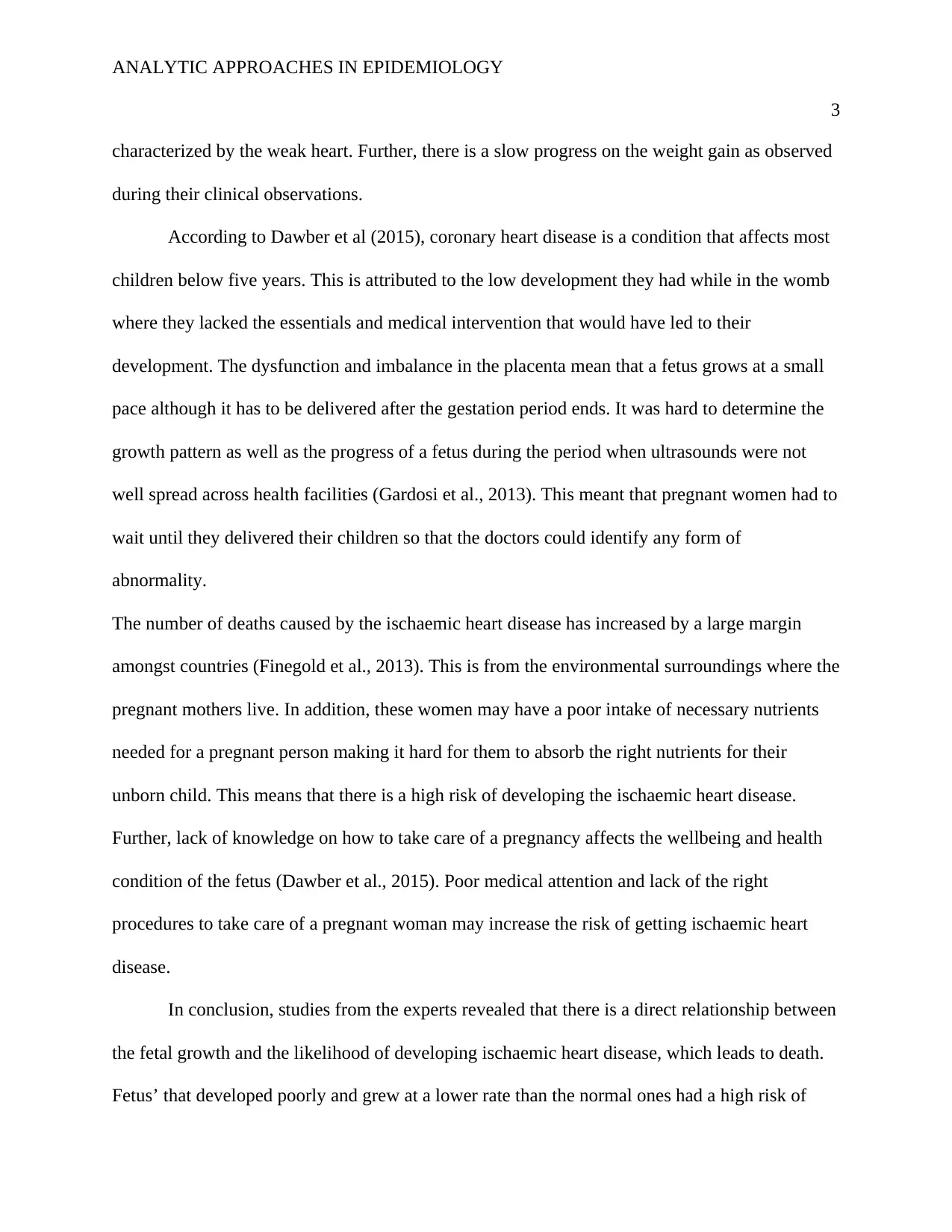
ANALYTIC APPROACHES IN EPIDEMIOLOGY
3
characterized by the weak heart. Further, there is a slow progress on the weight gain as observed
during their clinical observations.
According to Dawber et al (2015), coronary heart disease is a condition that affects most
children below five years. This is attributed to the low development they had while in the womb
where they lacked the essentials and medical intervention that would have led to their
development. The dysfunction and imbalance in the placenta mean that a fetus grows at a small
pace although it has to be delivered after the gestation period ends. It was hard to determine the
growth pattern as well as the progress of a fetus during the period when ultrasounds were not
well spread across health facilities (Gardosi et al., 2013). This meant that pregnant women had to
wait until they delivered their children so that the doctors could identify any form of
abnormality.
The number of deaths caused by the ischaemic heart disease has increased by a large margin
amongst countries (Finegold et al., 2013). This is from the environmental surroundings where the
pregnant mothers live. In addition, these women may have a poor intake of necessary nutrients
needed for a pregnant person making it hard for them to absorb the right nutrients for their
unborn child. This means that there is a high risk of developing the ischaemic heart disease.
Further, lack of knowledge on how to take care of a pregnancy affects the wellbeing and health
condition of the fetus (Dawber et al., 2015). Poor medical attention and lack of the right
procedures to take care of a pregnant woman may increase the risk of getting ischaemic heart
disease.
In conclusion, studies from the experts revealed that there is a direct relationship between
the fetal growth and the likelihood of developing ischaemic heart disease, which leads to death.
Fetus’ that developed poorly and grew at a lower rate than the normal ones had a high risk of
3
characterized by the weak heart. Further, there is a slow progress on the weight gain as observed
during their clinical observations.
According to Dawber et al (2015), coronary heart disease is a condition that affects most
children below five years. This is attributed to the low development they had while in the womb
where they lacked the essentials and medical intervention that would have led to their
development. The dysfunction and imbalance in the placenta mean that a fetus grows at a small
pace although it has to be delivered after the gestation period ends. It was hard to determine the
growth pattern as well as the progress of a fetus during the period when ultrasounds were not
well spread across health facilities (Gardosi et al., 2013). This meant that pregnant women had to
wait until they delivered their children so that the doctors could identify any form of
abnormality.
The number of deaths caused by the ischaemic heart disease has increased by a large margin
amongst countries (Finegold et al., 2013). This is from the environmental surroundings where the
pregnant mothers live. In addition, these women may have a poor intake of necessary nutrients
needed for a pregnant person making it hard for them to absorb the right nutrients for their
unborn child. This means that there is a high risk of developing the ischaemic heart disease.
Further, lack of knowledge on how to take care of a pregnancy affects the wellbeing and health
condition of the fetus (Dawber et al., 2015). Poor medical attention and lack of the right
procedures to take care of a pregnant woman may increase the risk of getting ischaemic heart
disease.
In conclusion, studies from the experts revealed that there is a direct relationship between
the fetal growth and the likelihood of developing ischaemic heart disease, which leads to death.
Fetus’ that developed poorly and grew at a lower rate than the normal ones had a high risk of
⊘ This is a preview!⊘
Do you want full access?
Subscribe today to unlock all pages.

Trusted by 1+ million students worldwide
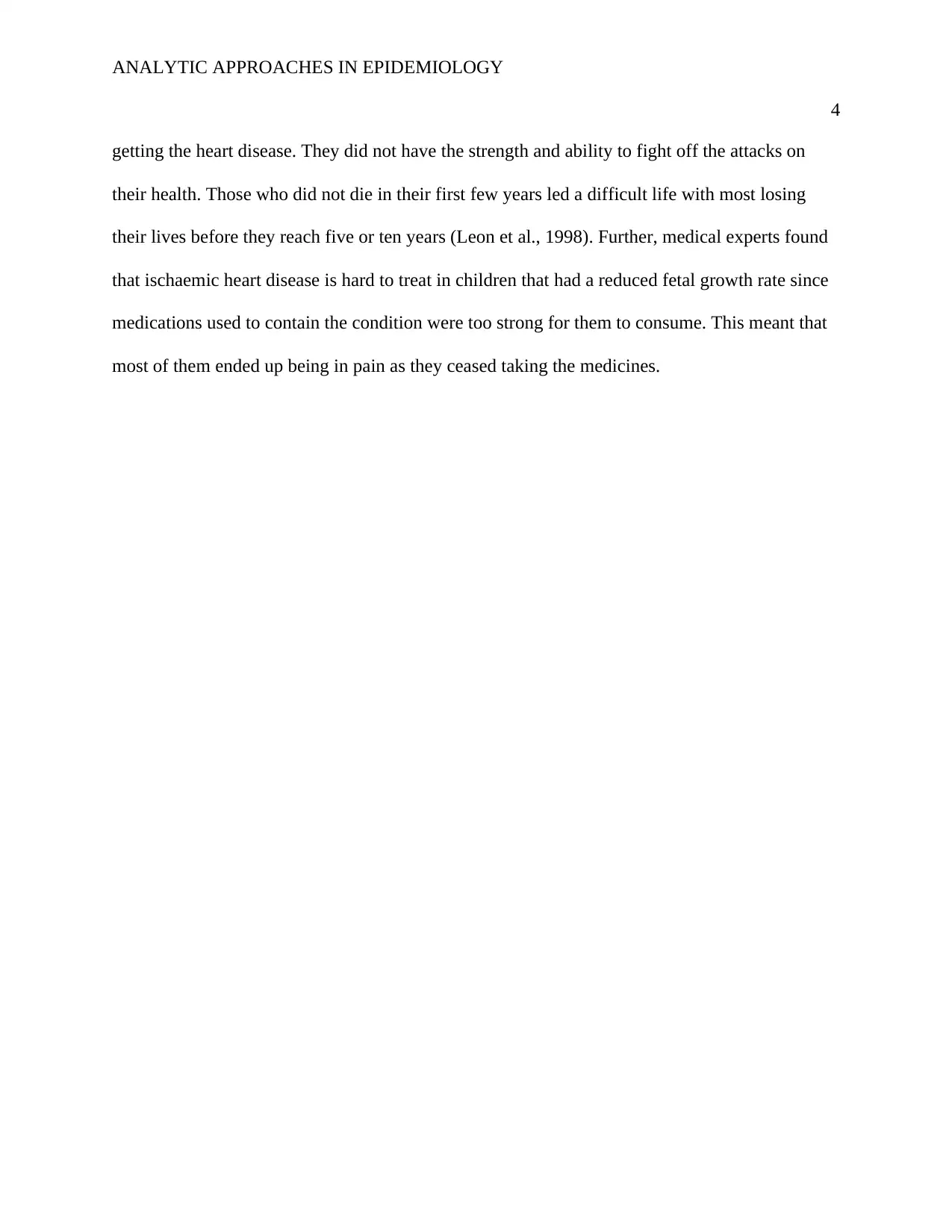
ANALYTIC APPROACHES IN EPIDEMIOLOGY
4
getting the heart disease. They did not have the strength and ability to fight off the attacks on
their health. Those who did not die in their first few years led a difficult life with most losing
their lives before they reach five or ten years (Leon et al., 1998). Further, medical experts found
that ischaemic heart disease is hard to treat in children that had a reduced fetal growth rate since
medications used to contain the condition were too strong for them to consume. This meant that
most of them ended up being in pain as they ceased taking the medicines.
4
getting the heart disease. They did not have the strength and ability to fight off the attacks on
their health. Those who did not die in their first few years led a difficult life with most losing
their lives before they reach five or ten years (Leon et al., 1998). Further, medical experts found
that ischaemic heart disease is hard to treat in children that had a reduced fetal growth rate since
medications used to contain the condition were too strong for them to consume. This meant that
most of them ended up being in pain as they ceased taking the medicines.
Paraphrase This Document
Need a fresh take? Get an instant paraphrase of this document with our AI Paraphraser
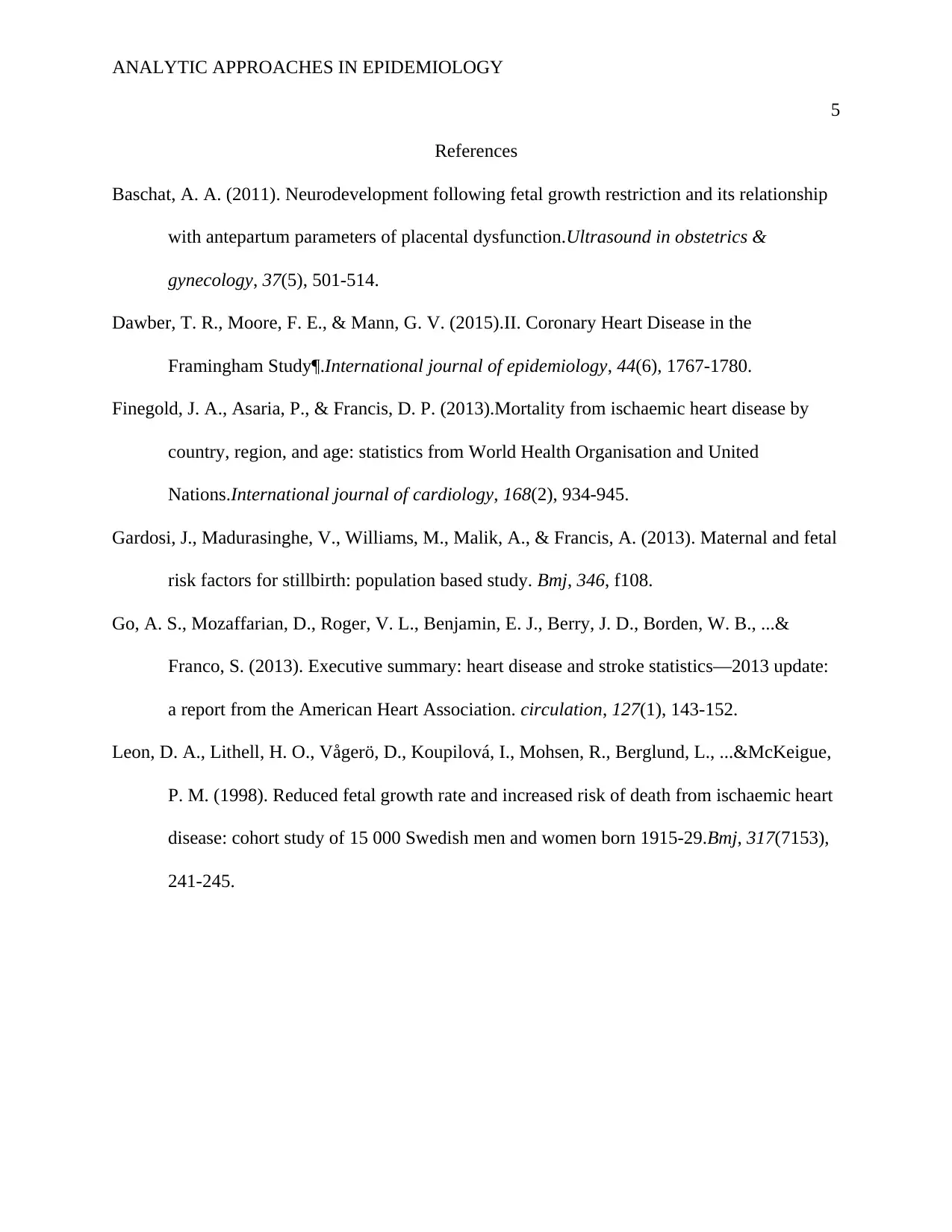
ANALYTIC APPROACHES IN EPIDEMIOLOGY
5
References
Baschat, A. A. (2011). Neurodevelopment following fetal growth restriction and its relationship
with antepartum parameters of placental dysfunction.Ultrasound in obstetrics &
gynecology, 37(5), 501-514.
Dawber, T. R., Moore, F. E., & Mann, G. V. (2015).II. Coronary Heart Disease in the
Framingham Study¶.International journal of epidemiology, 44(6), 1767-1780.
Finegold, J. A., Asaria, P., & Francis, D. P. (2013).Mortality from ischaemic heart disease by
country, region, and age: statistics from World Health Organisation and United
Nations.International journal of cardiology, 168(2), 934-945.
Gardosi, J., Madurasinghe, V., Williams, M., Malik, A., & Francis, A. (2013). Maternal and fetal
risk factors for stillbirth: population based study. Bmj, 346, f108.
Go, A. S., Mozaffarian, D., Roger, V. L., Benjamin, E. J., Berry, J. D., Borden, W. B., ...&
Franco, S. (2013). Executive summary: heart disease and stroke statistics—2013 update:
a report from the American Heart Association. circulation, 127(1), 143-152.
Leon, D. A., Lithell, H. O., Vågerö, D., Koupilová, I., Mohsen, R., Berglund, L., ...&McKeigue,
P. M. (1998). Reduced fetal growth rate and increased risk of death from ischaemic heart
disease: cohort study of 15 000 Swedish men and women born 1915-29.Bmj, 317(7153),
241-245.
5
References
Baschat, A. A. (2011). Neurodevelopment following fetal growth restriction and its relationship
with antepartum parameters of placental dysfunction.Ultrasound in obstetrics &
gynecology, 37(5), 501-514.
Dawber, T. R., Moore, F. E., & Mann, G. V. (2015).II. Coronary Heart Disease in the
Framingham Study¶.International journal of epidemiology, 44(6), 1767-1780.
Finegold, J. A., Asaria, P., & Francis, D. P. (2013).Mortality from ischaemic heart disease by
country, region, and age: statistics from World Health Organisation and United
Nations.International journal of cardiology, 168(2), 934-945.
Gardosi, J., Madurasinghe, V., Williams, M., Malik, A., & Francis, A. (2013). Maternal and fetal
risk factors for stillbirth: population based study. Bmj, 346, f108.
Go, A. S., Mozaffarian, D., Roger, V. L., Benjamin, E. J., Berry, J. D., Borden, W. B., ...&
Franco, S. (2013). Executive summary: heart disease and stroke statistics—2013 update:
a report from the American Heart Association. circulation, 127(1), 143-152.
Leon, D. A., Lithell, H. O., Vågerö, D., Koupilová, I., Mohsen, R., Berglund, L., ...&McKeigue,
P. M. (1998). Reduced fetal growth rate and increased risk of death from ischaemic heart
disease: cohort study of 15 000 Swedish men and women born 1915-29.Bmj, 317(7153),
241-245.
1 out of 5
Related Documents
Your All-in-One AI-Powered Toolkit for Academic Success.
+13062052269
info@desklib.com
Available 24*7 on WhatsApp / Email
![[object Object]](/_next/static/media/star-bottom.7253800d.svg)
Unlock your academic potential
Copyright © 2020–2025 A2Z Services. All Rights Reserved. Developed and managed by ZUCOL.





